Why scientists are interested in these rare New Zealand feral sheep
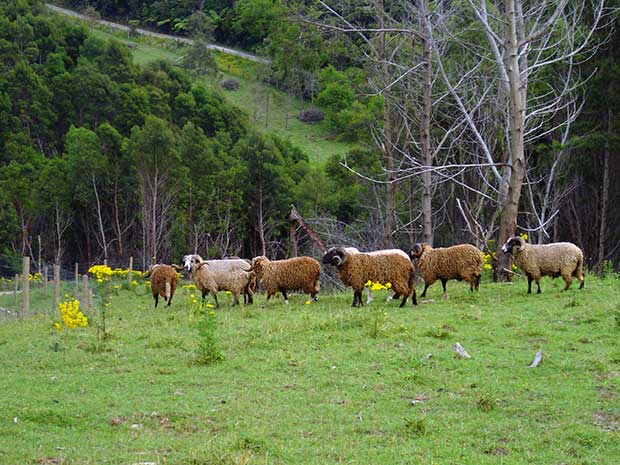
Part of the Aukett’s Mohaka flock.
These rare sheep breeds are living reminders of New Zealand’s colonial history, but may also hold the genes to future farming success and much more.
Words: Nadene Hall Photos: Demelza Aukett, Inger Keymer, and Michael Trotter
If you’ve ever watched Antiques Roadshow on TV, you’ll know the most important thing is provenance, being able to prove that the item in question is as old and important as you think it is.
When it comes to the rarest of the sheep breeds in New Zealand, it can be difficult to know 100% if offspring are still ‘pure’ but for Northland block owners Demelza and Lance Aukett, the provenance of their rare breed Mohaka sheep was never in doubt.
“We found a farmer in Rotorua who specifically wanted white Mohakas,” says Demelza. “He got them flown out of Mohaka by helicopter so we know they are true Mohakas and not crossed with anything else. He wanted to sell the black ones so we went down and got eight ewes and three rams.”
The original flock of fewer than 1000 merino-type sheep are believed to have been running wild in the Mohaka River area behind the historic Tutira sheep station, halfway between Gisborne and Wairoa, since the 1880s.
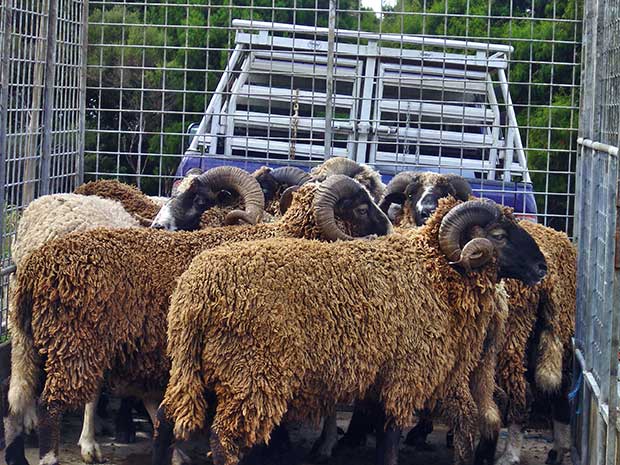
Hokonui sheep on the Aukett’s Northland farm.
Like most of the people who own the rarest of livestock breeds, the Auketts wanted to farm something a bit special says Demelza, and their Mohaka sheep are certainly that.
“They were different, they’re an ancient breed, nobody really had them when we first got them, just a few farms around the place.
“Originally we just wanted to maintain the breed and do our part to keep numbers up, we liked the rams with their big curly horns – the rams are really impressive.”
WHY SAVE THESE SHEEP?
New Zealand has 12 feral sheep populations either on the mainland, or on offshore islands. Of all of them, Arapawa Island sheep have become the most popular, for their attractive colours and hardy natures.
They now number in their thousands around the country, but other ferals such as the very rare Woodstock sheep – found on and named for Woodstock Station, west of Oxford in Canterbury – are only just hanging on and probably for not much longer.
“There’s still a few in the back country but not many in captivity, only two to three dozen,” says Michael Trotter of the NZ Rare Breeds Conservation Society and co-author of the 2010 book Rare Breeds of Heritage Livestock in New Zealand.
“And the fact is, some of the breeds like the Woodstock and the Clarence Reserve (a feral flock found near Marlborough) will die out because they don’t have sufficient interesting characteristics: they’re fairly plain, a large proportion are white, and people like something that’s interesting with different colours, that sort of thing.”
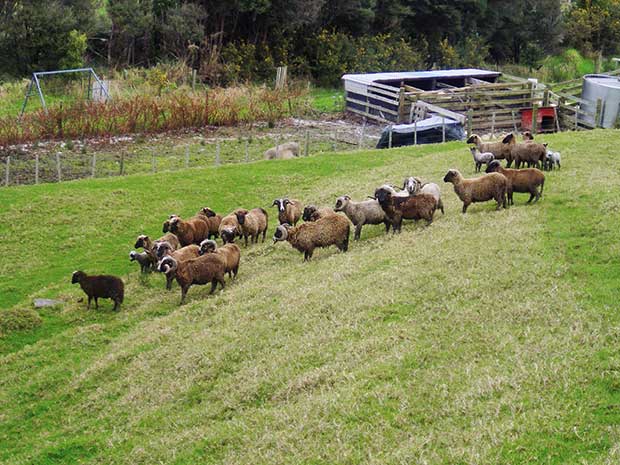
Flock of coloured Hokonui sheep.
New Zealand has proportionately more feral sheep breeds for its size than most other countries because of its isolation from the rest of the world and the remoteness of some of its islands. This has meant the genetics of 110+ years ago have been frozen in time, making these breeds of sheep exceptional for several reasons says Michael.
“They’re something very special to New Zealand. Most, but not all of them, are related to or descended from the very early merino sheep that came into New Zealand in the early 1800s. They’ve still got the genes from these early sheep, whereas the ones that are farmed commercially today have been developed over the years, they’ve changed them in all sorts of ways. The early genes are the sorts of things that breeders are really interested in.”
A second reason sounds like something you’d hear from an expert on antiques.
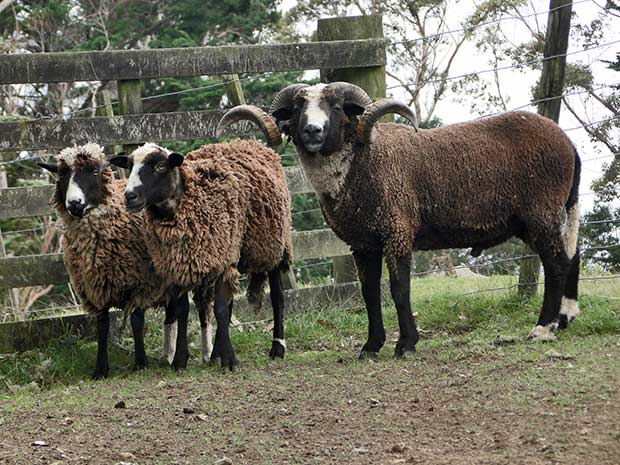
Arapawa ewes (left) with a shorn ram belonging to Clair Swan and Barry Jordan.
“There’s the desire of humans to relate to their past. We don’t like to kill off everything that’s old, it’s just like why we like old buildings – it’s a human condition.”
The final reason is economics: it may have a value to the farmers of tomorrow.
“Some of their genes are very useful,” says Michael. “A big problem for sheep is flystrike, worms, things like that but now they have these sheep that don’t get dags, they have little wool around their rear ends, they have bare bellies, and all those are characteristic genes found in rare breeds.”
These are the genes the scientists already know about but there may be more exciting genes waiting to be found.
“Take the Auckland Island pig,” says Michael. “Nobody knew there was anything special about those pigs. We (the NZ Rare Breeds Conservation Society) wanted to preserve them as an historical breed and we thought they might have some useful genes, so we spent a lot of time and energy trying to save them.
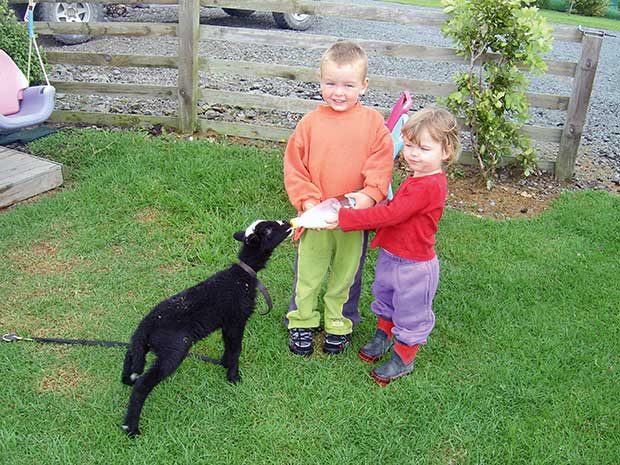
Mitchell (left) and Jade Aukett bottle-feeding Lilly.
“And when the scientists looked at them, they found they were disease-free, their genes made them virtually disease-free, and now they are able to do all sorts of work that makes them useful to humans in preventing and curing disease. Those pigs are very, very valuable.
“However, at this stage the valuable characteristics of (feral) sheep are probably more to do with wool and meat rather than the medical things.”
FARMING FERALS
Feral sheep are exceptional for their hardy natures, good health, parasite resistance, their ability to do well on rough or poor forage, and their wool-shedding. Sheep originally shed their wool as part of their natural seasonal cycle – it is only because of specific breeding by humans that commercial breeds now retain their wool and have to be shorn manually.
No matter how tame they become, feral sheep still remember what it’s like to be wild and so require slightly different treatment to the usual domesticated breeds: everyone who owns them agrees good quality fencing is a must.
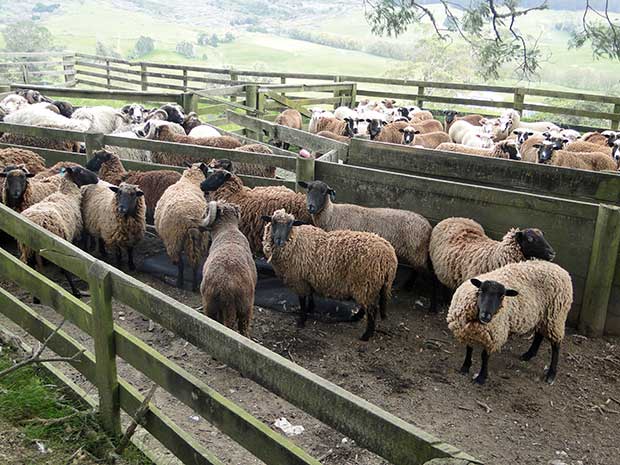
Pitt Island ewes and ram belonging to Clair Swan and Barry Jordan.
Barry Jordan and Clair Swan farm several different breeds of feral sheep on their block in the Bay of Islands. Barry says they really enjoy farming them, despite the challenges.
“The Arapawas are probably the easiest of the feral breeds, they’ll quieten down more quickly, become a bit more friendly.
The Pitt Islands are alright too but I’ve had one clear a wooden gate – a ram – and of course the rams can have quite big horns so you do have to be cautious about how you handle them, but then you should be cautious when dealing with any ram.”
He and Clair breed carefully to keep their small flocks of ferals ‘pure’ and sell them either at the local saleyards or to people on lifestyle blocks.
“There’s great pleasure in seeing them run around, they’re quite sociable animals, they live in little family groups, especially the Arapawas. We’ve got some that are quite colourful, quite different and we sell them. People are so thrilled seeing them running around their blocks, they get a real kick out of having them.”
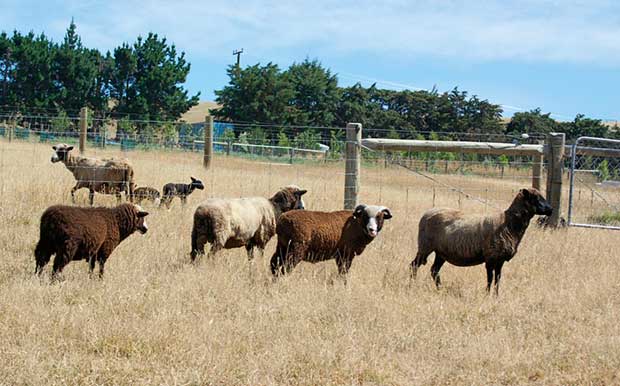
Pitt Island Sheep.
For Demelza and Lance Aukett, it was a slow and careful process to tame their genuinely wild feral sheep, although they had the advantage of owning a property that was surrounded by deer fencing.
“Ours were completely wild, it took them a long time to settle down,” says Demelza. “So I started feeding them multinuts! It took them a while to click on to it, but in the end they would come running when we called them, then they’d stand and wait as we put them out, then they’d all hoon over and they were as happy as, but still not completely tame.” Then came Lilly the lamb.
“We had a lamb go missing, we couldn’t find it anywhere. It was only two days old but somehow it managed to cross a state highway and get in with our neighbour’s bulls. It was living with them for four days! I went down and managed to catch it and it was in really good condition, I was very surprised. I managed to put it on the bottle and she was our pet.”
Lilly the lamb loved playing with the Aukett’s children, took over the backyard, and couldn’t wait to jump on the back of the ute and go for a drive with her human family.
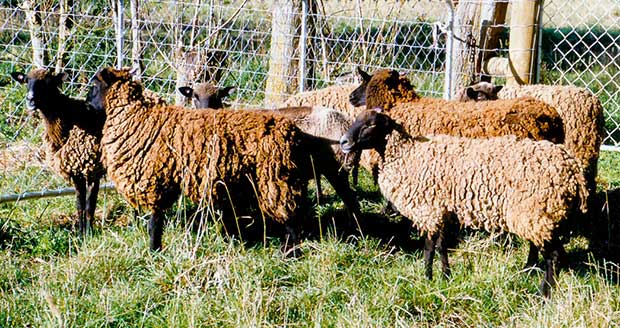
Herbert sheep.
“With her being tame, all the rest learned we weren’t a threat and they would come up with her, there was still the odd ewe that would linger in the background and not come right up.”
Lilly now lives with the flock, who are currently roaming over more than 100 acres of hilly terrain, keeping much to themselves and doing a great job eating out gorse, weeds and grass.
“We’ve had them five years now, and we’ve gone from having 10 acres to more than 300 acres (half in bush, half grazed), so they’ve pretty much gone wild again. Lilly will look up if you call her and you can see she wants to come over and see you but then she follows the flock.
We’re going to get them all back in soon and put them in (newly fenced) smaller paddocks, I don’t think it will take them too long (to get tame again).”
Their good size and shedding ability is also why Barry likes owning feral sheep, and selling them.
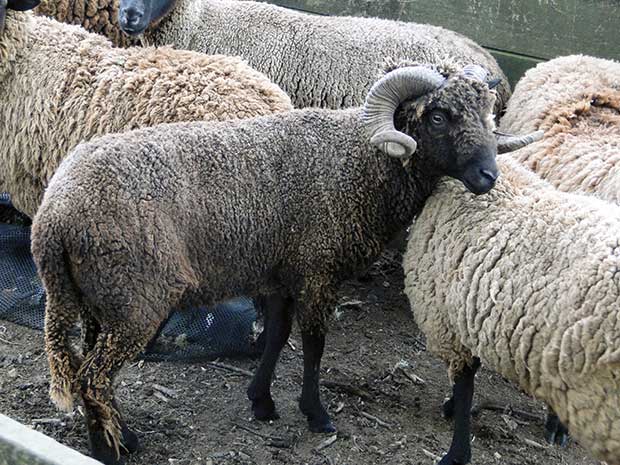
Pitt Island sheep.
“Most of them are medium-sized, they don’t get very big and that’s just natural selection on the kind of feed they would eat (in the wild). They’re mostly small-framed so they’re agile – they’ve got that in spades.
“We’ve sold a lot to people on lifestyle blocks because they like the colours, they’re easy care, they don’t need shearing (or much shearing), they don’t get footrot even up here (in the Far North), they don’t get flyblown, they’re clean around the crutch, there’s no belly wool.
“We’re really keen on them, they’re so much better than our other sheep, and they’re more popular now.”
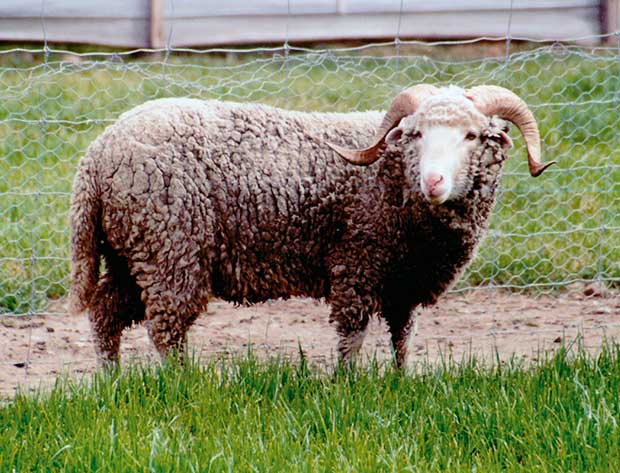
Woodstock sheep.
Breeding feral sheep and keeping the genetic lines ‘pure’ can be a problem, especially with the feral breeds that are low in numbers. In the wild, feral sheep are opportunist breeders, having lambs at any time of the year, but typically only one lamb per pregnancy. But get them on good feed and numbers can swell quickly, as Demelza and Lance have found out.
“We separate them at mating time but it’s a bit of mission. If you leave a ram lamb out with his mother, sometimes they’ll get big quickly and suddenly all the ewes are in lamb – they’ll lamb twice a year if you let them, and they’ll have twins both times!
“I think it’s because they’ve got a good amount of feed here, they can medicate themselves to a certain degree on a wide range of plants, and they’re extremely hardy, ours are pretty much organic and the majority shed their fleece – they’re a good breed in that respect.”
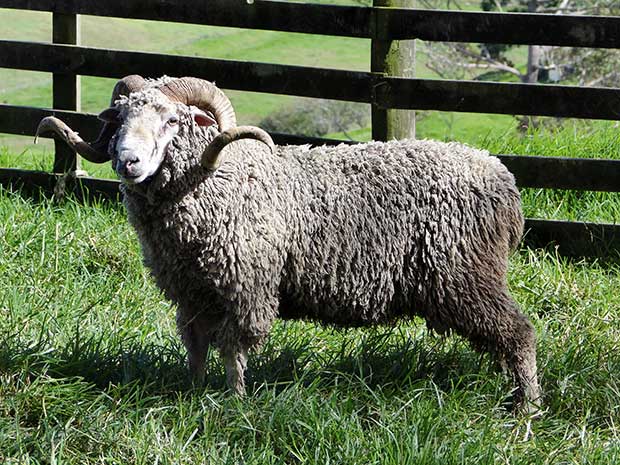
Diggers Hill sheep.
ON THE PLATE
Feral sheep breeds tend to be medium-sized, a case of survival of the fittest says Michael Trotter.
“To survive in the wild they’ve got to be fit and healthy, they mustn’t carry too much weight, a hefty sheep is not likely to survive. They don’t carry a lot of wool either and it sheds naturally. It’s hard to say but there must have been an awful lot of them that died (back when they first went wild), and these ones had the best genes to make it.”
The size and physical attributes make ferals an attractive breed to many block owners, but it’s the taste of the meat that Demelza Aukett and Barry Jordan agree makes them a stand-out.
“We’ve had some for the table, it’s beautiful meat, very lean,” says Demelza. “But in saying that, the last young ram we butchered had a lot of fat on him – really nice meat. And while I’ve never tried it my husband tells me they taste much more like goat.”
Barry believes that different taste – not gamey he hastens to add – may see some of the feral breeds become more of an economic option in years to come.
“There’s already a bit of commercial interest in the Pitt Islands, especially for the specialist restaurant trade, they have a particular taste. They’re nowhere near as fat (as a domestic sheep), their meat is a bit darker, it has sort-of a mutton flavour. It’s hard to explain a taste!”
READ MORE
Love this story? Subscribe now!
 This article first appeared in NZ Lifestyle Block Magazine.
This article first appeared in NZ Lifestyle Block Magazine.

